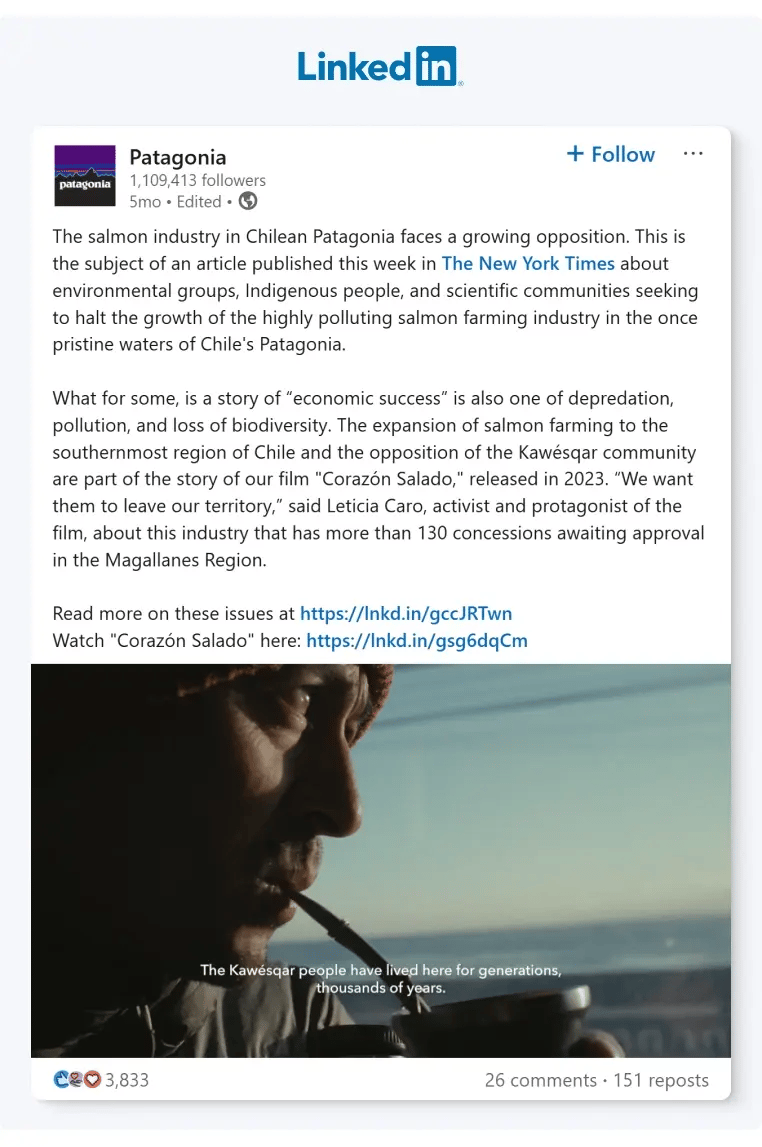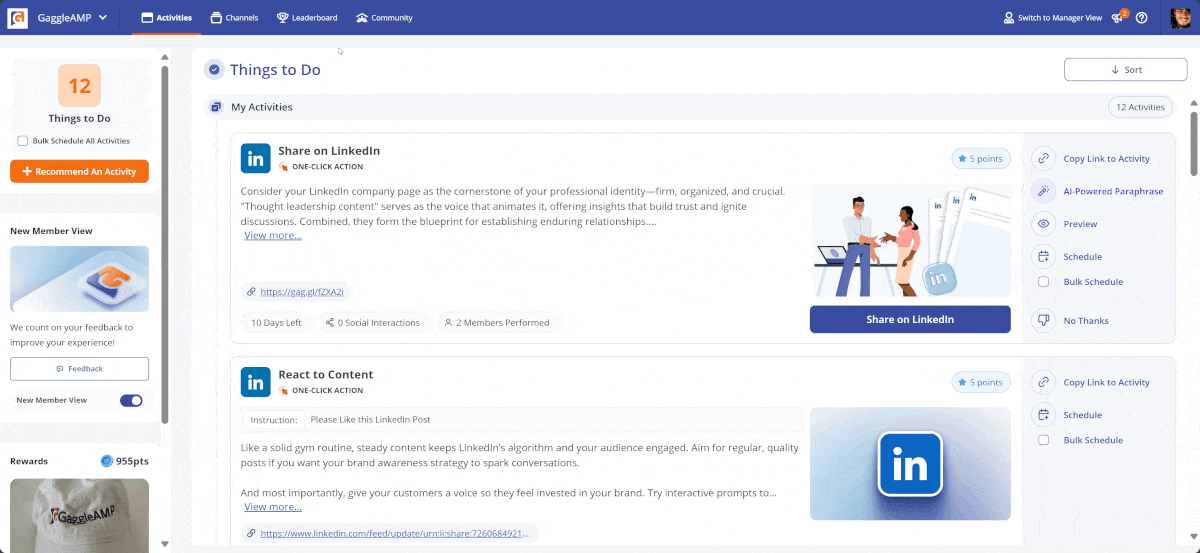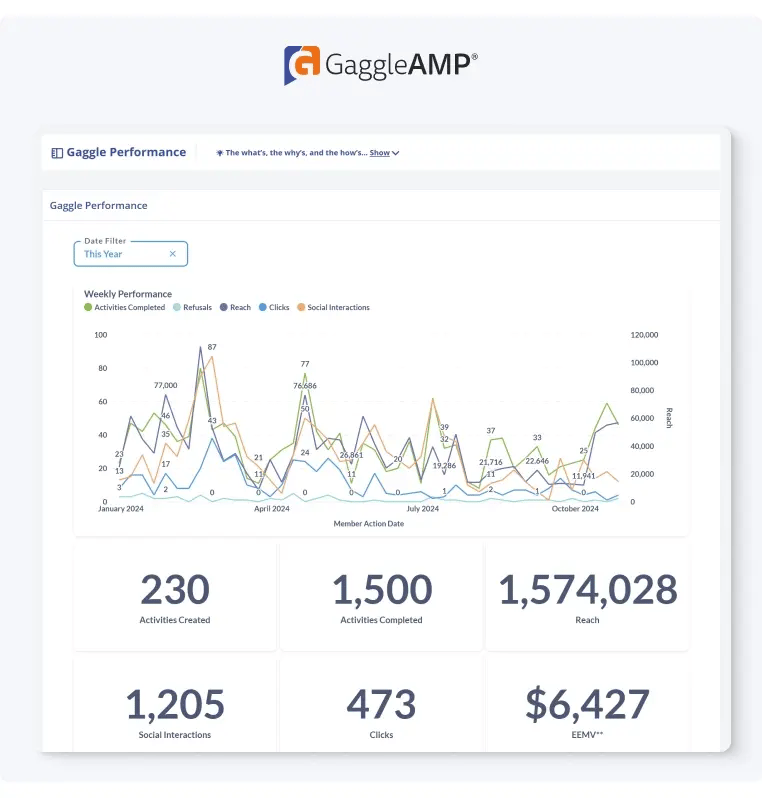As you explore the following trends, consider how each one could strengthen or evolve your current organic social media strategy.
1. AI-Driven Personalization
Artificial intelligence (AI) continues to transform social media marketing, enabling hyper-personalized content delivery. For B2B brands, AI tools analyze audience behavior, segment audiences by preferences, and deliver tailored experiences. AI also helps automate repetitive tasks like scheduling, making it easier to focus on creating high-quality content.
| Benefits | Obstacles |
|
|
AI tools use machine learning to analyze historical engagement patterns, helping marketers predict the best times to post, the ideal formats, and messaging styles for specific audience segments. According to McKinsey, companies using AI for personalization saw a 20% increase in engagement rates compared to those that didn’t.
To leverage this trend, B2B marketers should adopt tools like ChatGPT for content generation or AI-driven platforms like Sprinklr to personalize messaging and enhance audience engagement.
2. Authentic Engagement
Audiences crave authenticity. Brands that engage transparently and allow employees to share their voices build stronger connections. Authenticity also involves acknowledging challenges, celebrating successes, and connecting with audiences on a human level.
| Benefits | Obstacles |
|
|
Authentic engagement relies on direct, honest communication, often showcasing behind-the-scenes content, real employee stories, or unscripted interactions. A survey by Social Media Today found that 90% of Millennials prioritize brand authenticity, indicating a strong preference for 'real and organic' over 'perfect and packaged' content.
Encouraging employees to participate in organic campaigns not only amplifies reach but also fosters trust. For example, the #WomenInSTEM campaign from IBM showcased real employees sharing their stories, generating over 2 million impressions organically on LinkedIn.

3. Short-Form Video Dominance
Short-form videos continue to dominate organic reach across platforms. For B2B brands, platforms like LinkedIn and Instagram Reels are becoming essential for capturing attention. These videos are perfect for simplifying complex topics, making them more digestible for B2B audiences.
| Benefits | Obstacles |
|
|
Short-form videos focus on delivering concise, impactful messages in under 60 seconds, leveraging storytelling techniques. Wyzowl’s 2025 report found that 69% of video marketers have created social media videos, highlighting the significant role of short-form content in current marketing strategies.
B2B marketers should invest in producing educational, bite-sized videos that address customer pain points. See how HubSpot consistently achieves high engagement through their Instagram reels, with many exceeding 10,000 views within 24 hours, by offering quick marketing tips.

4. Community-Centric Strategies
Building communities around shared interests is a growing focus for B2B brands. These communities foster deeper relationships and increase brand loyalty by enabling members to engage directly with the brand and with one another.
| Benefits | Obstacles |
|
|
Through platforms like LinkedIn Groups, Slack, or even proprietary apps, brands can create spaces for discussions, knowledge-sharing, and networking; thus, creating thriving B2B communities.
According to recent data from CreatorLabz, 86% of businesses report that community management is essential for their success, with 72% planning to increase their investment in 2025.
The best example of this trend is how Salesforce’s Trailblazer Community connects users to share knowledge, tips, and success stories, driving organic growth and advocacy.

According to recent data from CreatorLabz, 86% of businesses report that community management is essential for their success, with 72% planning to increase their investment in 2025.
5. Data-Driven Decision Making
Advanced analytics tools allow B2B marketers to refine organic strategies based on audience behavior and campaign performance. Data helps identify what works and what doesn’t, ensuring continuous improvement.
| Benefits | Obstacles |
|
|
Analytics platforms gather insights on user engagement, demographics, and sentiment to inform content strategies. A survey by Drexel University’s LeBow College of Business revealed that 77% of data and analytics professionals prioritize data-driven decision-making in their programs, emphasizing its critical role in achieving operational efficiency, cost reduction, revenue generation, and regulatory compliance.
According to an IBM case study, the company transformed its marketing approach by utilizing Adobe Experience Cloud to optimize people, processes, and technology platforms. This transformation enabled IBM to deliver personalized experiences at scale, ensuring that web pages and case studies are relevant to individual clients and industries.
6. Creator-Led Collaborations
B2B brands are increasingly collaborating with niche creators to drive organic growth. These partnerships lend credibility and expand audience reach by introducing brands to creators’ dedicated followers.
| Benefits | Obstacles |
|
|
So, how does this work? Brands often partner with creators who align with their values and expertise, creating authentic content that resonates with both audiences. A report by Traackr found that 61% of marketers view creators as essential to organic growth strategies.
Here is a great example from the Head of Marketing at Capsule detailing her experience with influencer campaigns:
7. Cross-Platform Integration
Managing consistent messaging across platforms has become critical for B2B brands aiming to maximize organic reach. This ensures that campaigns reinforce brand identity regardless of where audiences engage.
| Benefits | Obstacles |
|
|
Integration tools enable marketers to create, schedule, and analyze content performance across multiple platforms. A recent study shows that 84% of marketers recognize that multichannel campaigns are more effective than single-channel campaigns.
Tools like Buffer or GaggleAMP streamline cross-platform content management and scheduling.
8. Employee Advocacy and User-Generated Content (UGC)
Empowering employees to share content amplifies reach and boosts credibility. Similarly, UGC showcases authentic brand interactions, fostering trust and engagement. Employee advocacy is a powerful strategy for authentically showcasing your brand to your ideal audience across social media.
| Benefits | Obstacles |
|
|
Platforms like GaggleAMP simplify advocacy by enabling employees to share approved content while gamifying the process for motivation. This will empower your employees and turn them into powerful social sellers.
To validate the impact of employee advocacy, we conducted a study surveying social media marketing professionals who currently manage a formal employee advocacy program. Amongst the most important advocacy statistics, we found out that 73% of social media managers report that employee advocacy doubles their brand’s social media engagement, making it a crucial part of their marketing strategies.
9. Ethical and Sustainable Messaging
Modern audiences are drawn to brands that align with their values. Ethical messaging can significantly enhance organic engagement, especially for younger demographics.
| Benefits | Obstacles |
|
|
Brands share stories and initiatives reflecting their ethical commitments, such as sustainability or community impact. Patagonia's commitment to sustainability effectively engages a dedicated audience, as evidenced by the significant interaction their posts generate.

Sharing content that reflects genuine values resonates deeply with audiences. A survey by PwC found that consumers are willing to spend an average of 9.7% more on sustainably produced or sourced goods, even amidst cost-of-living and inflationary concerns.
10. The Shift Toward Visual-First Content
Visual storytelling through infographics, carousels, and multimedia posts is essential for capturing attention in a crowded digital landscape.
| Benefits | Obstacles |
|
|
Combining data and visuals simplifies complex messages, making them more engaging and shareable. Canva’s carousel posts on LinkedIn showcasing design tips often garner a considerable amount of reactions and reshares within a couple of days.

According to Venngage, more than 50% of marketers agree that visual content is essential to their marketing strategy. This emphasizes the crucial role of capturing your audience's attention, enhancing engagement, and making brand messaging more memorable.
How GaggleAMP Enhances Social Media Strategies
AI-Powered Paraphrasing for Content Creation
GaggleAMP’s AI-powered paraphrasing tool allows employees to share personalized versions of posts, ensuring originality and consistency across platforms. For example, B2B brands can leverage this feature to scale content creation effortlessly while maintaining brand integrity.

Employee Advocacy and Gamification
With gamification features, GaggleAMP motivates employees to participate in organic campaigns. Leaderboards, rewards, and Slack notifications make advocacy engaging and fun, driving higher participation rates.
Analytics and Reporting
GaggleAMP provides robust analytics to track the performance of employee advocacy efforts, including engagement metrics, audience reach, and ROI.

Seamless Platform Integration
Supporting multiple platforms such as LinkedIn, Instagram, X (formerly Twitter), and more, GaggleAMP ensures consistent messaging and a streamlined content management experience.
Ready to Future-Proof Your B2B Social Media Strategy?
The organic social media landscape is evolving rapidly, with trends like AI personalization, authentic engagement, and employee advocacy shaping the future of B2B marketing. By embracing these trends and leveraging tools like GaggleAMP, businesses can stay ahead of the curve, foster meaningful connections, and drive sustainable growth. Start preparing your strategy for 2025 today!













